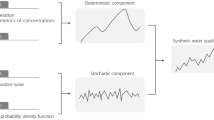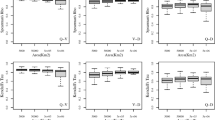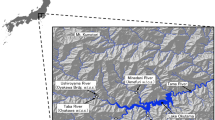Abstract
The accurate knowledge about the influence of time in the behavior of rivers systems is crucial for a proper river basin water management. Traditional techniques such as correlograms or ARMA models have been widespread used over the last decades providing the analyzer with an average behaviour of temporal influence of hydrological series. In the last decade, the development of techniques, under the discipline of artificial intelligent, have increased the range of available analytical tools. On the other hand, hydrological processes have a very strong random nature and they are driven by its high uncertainty and variability. Consequently, it is necessary to build tools, able to incorporate these peculiarities in their analytical functioning. Causal Reasoning through Bayesian Networks (BNs) allows processing and analysing hydrological series, incorporating and assessing all their variability. Causality driven by Bayes´ theorem is used here to dynamically identify, characterize and quantify the influence of time (dependence) for each time step in annual run-off series in five Spanish River basins. Therefore, BNs arise as a powerful tool for getting a deeper understanding on the knowledge of temporal behaviour of hydrological series because this analysis is dynamic and implemented specifically for temporal iterations (decision variables). Implications and applications of this research are largely aimed to improve and optimize the design and dimensioning of hydraulic infrastructures, as well as reducing the risk of negative impacts produced by extreme events such as several droughts or floods, among others.






Similar content being viewed by others
References
Akintug B, Rasmussen PF (2005) A Markov switching model for annual hydrologic time series. Water Resour Res 41:W09424
ASCE Task Committee on Application of Artificial Neural Networks in Hydrology (2000a) Artificial neural networks in hydrology. I: preliminary concepts. J Hydrol Eng 5:115–123
ASCE Task Committee on Application of Artificial Neural Networks in Hydrology (2000b) Artificial neural networks in hydrology. Ii: hydrologic applications. J Hydrol Eng 5:124–137
Cain J (2001) Planning improvements in natural resources management. Centre for Ecology and Hydrology, Wallingford
Carmona G, Varela-Ortega C, Bromley J (2013) Supporting decision making under uncertainty: development of a participatory integrated model for water management in the middle Guadiana river basin. Environ Model Softw 50:144–157
Castelletti A, Soncini-Sessa R (2007) Bayesian networks and participatory modelling in water resource management. Environ Model Softw 22:1075–1088
Chang FJ, Chang YT (2006) Adaptive neuro-fuzzy inference system for prediction of water level in reservoir. Adv Water Resour 29:1–10
Consorcio de Compensación de Seguros (2017) La cobertura de los riesgos extraordinarios en España. Depósito Legal: M-38845-2015
Croitoru A, Minea I (2015) The impact of climate changes on rivers discharge in eastern Romania. Theor Appl Climatol 120:563–573
Daliakopoulos IN, Coulibaly P, Tsanis IK (2005) Groundwater level forecasting using artificial neural networks. J Hydrol 309:229–240
Díaz Caballero FF (2011) Selección de modelos mediante criterios de información en análisis factorial: aspectos teóricos y computacionales. Tesis doctoral, Universidad de Granada, Granada
Genc O, Dag A (2016) A machine learning-based approach to predict the velocity profiles in small streams. Water Resour Manag 30:43–61
Hurst HE (1951) Long-term storage capacity of reservoirs. T Am Soc Civ Eng 116:770–808
Iglesias A, Garrote L, Flores F, Moneo M (2007) Challenges to manage the risk of water scarcity and climate change in the Mediterranean. Water Resour Manag 21:775–788
Ilich N, Despotovic J (2008) A simple method for effective multi-site generation of stochastic hydrologic time series. Stoch Env Res Risk A 22:265–279
Jain A, Kumar AM (2007) Hybrid neural network models for hydrologic time series forecasting. Appl Soft Comput 7:585–592
Jayakrishnan R, Srinivasan R, Santhi C, Arnold JG (2005) Advances in the application of the SWAT model for water resources management. Hydrol Process 19:749–762
Jensen FV (2001) Bayesian network and decision graphs. Department of Computer Science, Aalborg University, Aalborg
Karthikeyan L, Kumar DN (2013) Predictability of nonstationary time series using wavelet and EMD based ARMA models. J Hydrol 502:103–119
Kendall DR, Dracup JA (1991) A comparison of index-sequential and Ar(1) generated hydrologic sequences. J Hydrol 122:335–352
Koutroumanidis T, Sylaios G, Zafeiriou E, Tsihrintzis VA (2009) Genetic modeling for the optimal forecasting of hydrologic time-series: application in Nestos River. J Hydrol 368:156–164
Kumar DN, Raju KS, Sathish T (2004) River flow forecasting using recurrent neural networks. Water Resour Manag 18:143–161
Lall U, Sharma A (1996) A nearest neighbor bootstrap for resampling hydrologic time series. Water Resour Res 32:679–693
MAGRAMA (2015) http://www.magrama.gob.es/es/agua/temas/seguridad-de-presas-y-embalses/desarrollo/. Accessed 11 Nov 2015
Molina JL, Bromley J, Garcia-Arostegui JL, Sullivan C, Benavente J (2010) Integrated water resources management of overexploited hydrogeological systems using object-oriented Bayesian networks. Environ Model Softw 25:383–397
Molina JL, Pulido-Velazquez D, Luis Garcia-Arostegui J, Pulido-Velazquez M (2013) Dynamic Bayesian networks as a decision support tool for assessing climate change impacts on highly stressed groundwater systems. J Hydrol 479:113–129
Mondal MS, Chowdhury JU (2013) Generation of 10-day flow of the Brahmaputra River using a time series model. Hydrol Res 44:1071–1083
Mousavi SJ, Ponnambalam K, Karray F (2007) Inferring operating rules for reservoir operations using fuzzy regression and ANFIS. Fuzzy Sets Syst 158:1064–1082
Mun J (2010) Modeling risk (second edition): applying monte carlo simulation, real options analysis, forecasting, and optimization. Wiley Risk Simulator 10.00, 2014. http://www.realoptionsvaluation.com/
Myung IJ (2000) The importance of complexity in model selection. J Math Psychol 44:190–204
Nodelman U, Horvitz E, (2003) Continuous time bayesian networks for inferring users’ presence and activities with extensions for modeling and evaluation. Microsoft Research
Nourani V, Kisi O, Komasi M (2011) Two hybrid artificial intelligence approaches for modeling rainfall-runoff process. J Hydrol 402:41–59
Patel SS, Ramachandran P (2015) A comparison of machine learning techniques for modeling river flow time series: the case of upper Cauvery river basin. Water Resour Manag 29:589–602
Pearl J (1988) Probabilistic reasoning in intelligent systems: networks of plausible inference. Morgan Kaufmann, San Francisco
Pena JM, Lozano JA, Larranaga P (2004) Unsupervised learning of Bayesian networks via estimation of distribution algorithms: an application to gene expression data clustering. Int J Uncertainty Fuzziness 12:63–82
Pulido-Velazquez D, Luis Garcia-Arostegui J, Molina J, Pulido-Velazquez M (2015) Assessment of future groundwater recharge in semi-arid regions under climate change scenarios (Serral-Salinas aquifer, SE Spain). Could increased rainfall variability increase the recharge rate? Hydrol Process 29:828–844
Rajagopalan B, Salas JD, Lall U (2010) Stochastic methods for modeling precipitation and streamflow. In: Berndtsson R, Sivakumar B (eds) Advances in data-based approaches for hydrologic modeling and forecasting. World Scientific, Singapore, pp 17–52
Said A (2006) The implementation of a Bayesian network for watershed management decisions. Water Resour Manag 20:591–605
Salas JD (1993) Analysis and modeling of hydrologic time series. In: Maidment DR (ed) Handbook of hydrology. The McGraw Hill, New York, pp 1–72
Salas J, Delleur J, Yevjevich V (1980) Applied modeling of hydrologic time series. Water Resources Publications, Colorado
Sang Y, Wang Z, Liu C (2015) Wavelet neural modeling for hydrologic time series forecasting with uncertainty evaluation. Water Resour Manag 29:1789–1801
Sharma A, Tarboton DG, Lall U (1997) Streamflow simulation: a nonparametric approach. Water Resour Res 33:291–308
Srivastav RK, Srinivasan K, Sudheer KP (2011) Simulation-optimization framework for multi-season hybrid stochastic models. J Hydrol 404:209–225
Stojkovic M, Prohaska S, Plavsic J (2015) Stochastic structure of annual discharges of large European rivers. J Hydrol Hydromech 63:63–70
Valipour M, Banihabib ME, Behbahani SMR (2013) Comparison of the ARMA, ARIMA, and the autoregressive artificial neural network models in forecasting the monthly inflow of Dez dam reservoir. J Hydrol 476:433–441
Varis O, Fraboulet-Jussila S (2002) Water resources development in the lower Senegal River basin: conflicting interests, environmental concerns and policy options. Int J Water Resour Dev 18:245–260
Wang Y, Traore S, Kerh T, Leu J (2011) Modelling reference evapotranspiration using feed forward backpropagation algorithm in arid regions of Africa. Irrig Drain 60:404–417
Zhao X, Chen X (2015) Auto regressive and ensemble empirical mode decomposition hybrid model for annual runoff forecasting. Water Resour Manag 29:2913–2926
Zounemat-Kermani M, Teshnehlab M (2008) Using adaptive neuro-fuzzy inference system for hydrological time series prediction. Appl Soft Comput 8:928–936
Author information
Authors and Affiliations
Corresponding author
Rights and permissions
About this article
Cite this article
Molina, JL., Zazo, S. Causal Reasoning for the Analysis of Rivers Runoff Temporal Behavior. Water Resour Manage 31, 4669–4681 (2017). https://doi.org/10.1007/s11269-017-1772-9
Received:
Accepted:
Published:
Issue Date:
DOI: https://doi.org/10.1007/s11269-017-1772-9




